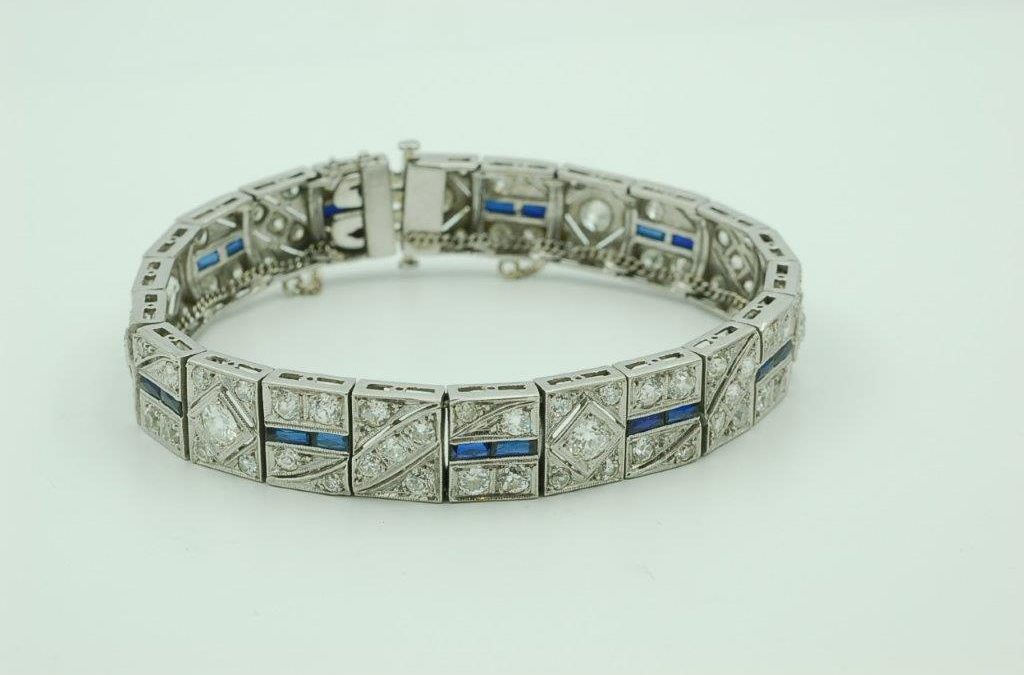Estate vintage jewelry offers an extraordinary opportunity for collectors, fashion enthusiasts, and first-time buyers to own a piece of history. Whether you’re buying for its beauty, its craftsmanship, or its historical value, estate jewelry has a charm that modern pieces often can’t match. However, for first-time buyers, navigating an estate vintage jewelry sale can feel overwhelming. Here’s a comprehensive guide on what to look for when buying estate vintage jewelry, helping you make an informed decision.
Understanding Estate Jewelry
What Is Estate Jewelry?
Estate jewelry refers to any piece of jewelry that has been previously owned. This doesn’t necessarily mean the piece is antique or vintage, as estate jewelry can also include contemporary pieces. Typically, the term is used for items that are pre-owned but in excellent condition.
What Qualifies as Vintage?
Vintage jewelry generally refers to pieces that are at least 20-30 years old. The term encompasses several stylistic periods, from the Art Deco designs of the 1920s to the bold, geometric styles of the 1980s. When shopping for estate vintage jewelry, understanding these eras can help you better appreciate the piece you’re buying.
Why Buy Estate Vintage Jewelry?
Unique and One-of-a-Kind Pieces
One of the main attractions of estate vintage jewelry is the uniqueness of each piece. Unlike mass-produced modern jewelry, estate jewelry often features hand-crafted details and rare gemstones, making it truly one-of-a-kind.
Superior Craftsmanship
Vintage jewelry is often more intricately designed than contemporary pieces. Older methods of craftsmanship, like hand engraving and filigree work, showcase a level of detail that is harder to find in modern jewelry.
Value for Money
Because estate jewelry is pre-owned, it is typically priced lower than similar new pieces. This means you can often get high-quality gemstones and precious metals for a fraction of the price of new jewelry.
Tips for First-Time Buyers
1. Research Before You Buy
Before attending an estate vintage jewelry sale in WI, it’s essential to do your homework. Research different jewelry periods, familiarize yourself with common styles and materials, and learn how to identify authentic vintage pieces. This will give you the confidence to make informed decisions.
2. Examine the Condition
When buying estate jewelry, condition is everything. Look for signs of wear such as scratches, loose stones, or missing components. While minor imperfections can be expected in older pieces, extensive damage can affect the jewelry’s value and wearability.
What to Check:
- Clasp and setting security: Ensure that the clasp closes properly and that the stones are securely set.
- Metal integrity: Look for any signs of tarnishing, bending, or thinning of the metal.
- Gemstone condition: Examine the stones for chips, cracks, or discoloration.
3. Verify the Authenticity
Authenticity is key when buying estate vintage jewelry. Ensure you’re purchasing from a reputable dealer who can provide information on the jewelry’s provenance, or history of ownership.
Look for:
- Hallmarks: Stamps or marks that indicate the metal content or the designer.
- Era-specific designs: Familiarize yourself with the styles of different periods (Art Deco, Victorian, etc.) to help authenticate a piece.
4. Pay Attention to Gemstones
The gemstones in estate jewelry are often natural and untreated, unlike many modern stones which may be heat-treated or chemically enhanced. However, it’s important to verify this with the seller. Natural gemstones often come with minor imperfections that add to their character.
Key Points for Gemstone Evaluation:
- Clarity: Look for stones that are clear and free of significant inclusions or flaws.
- Cut: Vintage cuts may be different from modern ones. For example, older diamonds may have more facets, resulting in a subtler sparkle.
- Origin: If possible, inquire about the gemstone’s origin. Certain locations, like Kashmir for sapphires or Colombia for emeralds, are known for producing high-quality stones.
5. Ensure Proper Certification
For high-value pieces, it’s crucial to obtain a certification from a trusted organization like the Gemological Institute of America (GIA) or the American Gem Society (AGS). Certification verifies the authenticity and quality of the gemstones and can significantly enhance the resale value of the piece.
6. Invest in Professional Appraisal
Before finalizing your purchase, especially if you’re buying a high-ticket item, consider getting the jewelry appraised by a certified gemologist. An appraisal provides a detailed report on the item’s condition, value, and any repairs or alterations made over time.
What to Expect at an Estate Vintage Jewelry Sale
1. The Selection
Estate vintage jewelry sales in Wisconsin, including at trusted venues like Lee Dorn Jewelers, often feature a wide variety of pieces from different eras. You might come across vintage engagement rings, necklaces, brooches, and more. Expect to see items that range from simple gold pieces to intricate designs with gemstones.
2. Pricing
Prices at estate jewelry sales can vary widely depending on factors such as the designer, the materials, the era, and the overall condition. It’s wise to set a budget before attending the sale, but keep in mind that estate jewelry is often an excellent value compared to brand-new pieces.
3. Negotiating Prices
In some cases, it may be possible to negotiate the price, especially if the piece has been in inventory for a while or if there are minor imperfections. Be polite but firm, and always be prepared to walk away if the price doesn’t align with your budget.
Important Jewelry Periods to Know
Understanding the different design periods can help you appreciate the history and craftsmanship behind each estate vintage jewelry piece.
1. Victorian Era (1837-1901)
Victorian jewelry is often characterized by intricate designs, romantic motifs, and the use of natural materials like coral and seed pearls. Pieces from this era often feature lockets, cameos, and mourning jewelry.
2. Art Nouveau (1890-1915)
Known for its flowing, nature-inspired designs, Art Nouveau jewelry often incorporates elements like flowers, vines, and insects. It was a reaction against the industrialization of the time and emphasized handcrafted details.
3. Edwardian Era (1901-1915)
Edwardian jewelry is known for its elegance and sophistication, often featuring delicate filigree work, platinum settings, and the use of diamonds and pearls. This era’s jewelry is highly sought after for its intricate craftsmanship.
4. Art Deco (1920s-1930s)
Art Deco jewelry is defined by its bold geometric shapes, strong lines, and vibrant colors. Popular gemstones during this period include diamonds, emeralds, and sapphires, often set in platinum or white gold.
5. Retro (1940s-1950s)
Jewelry from the Retro era is larger and more colorful, often featuring oversized gemstones and whimsical designs. This period was influenced by Hollywood glamour and the post-war era’s optimism.
Red Flags to Watch For
While estate vintage jewelry offers many advantages, there are also potential pitfalls to watch out for.
1. Unverified Sellers
Avoid purchasing estate jewelry from sellers who cannot provide information about the item’s history or who are unwilling to offer a certification. Stick to reputable jewelers like Lee Dorn Jewelers, who specialize in estate vintage jewelry sales in Wisconsin.
2. Obvious Repairs
Repairs, especially those done poorly, can diminish the value of an estate piece. Look closely for signs of soldering, replacement stones, or other modifications that may not align with the original design.
3. Fake Vintage
Some unscrupulous sellers may try to pass off modern reproductions as vintage pieces. To avoid being scammed, do your research and only buy from reputable dealers who can provide authentication.
FAQs: Estate Vintage Jewelry
| Question | Answer |
| What is estate vintage jewelry? | Estate vintage jewelry refers to pre-owned pieces that are typically 20-30 years old, though some may be much older. |
| Why should I buy estate jewelry? | Estate jewelry offers unique designs, superior craftsmanship, and excellent value compared to new pieces. |
| How can I authenticate a vintage piece? | Look for hallmarks, era-specific designs, and ask for certifications from trusted organizations like GIA or AGS. |
| What are common signs of wear in estate jewelry? | Signs of wear can include tarnishing, loose stones, scratches, or thinning metal. |
| Is it possible to negotiate prices at estate sales? | Yes, in some cases, especially if the piece has been in inventory for a while or has minor imperfections. |
| Do vintage gemstones differ from modern ones? | Yes, vintage gemstones are often untreated and may feature cuts that differ from modern standards, adding to their unique appeal. |
Estate vintage jewelry is not only a fashion statement but also an investment in history. By keeping these tips in mind, first-time buyers can navigate an estate vintage jewelry sale WI with confidence and find a timeless piece that aligns with their style and budget. For a trusted selection of estate vintage jewelry, consider visiting Lee Dorn Jewelers, where you’ll find expertly curated pieces and exceptional customer service.

